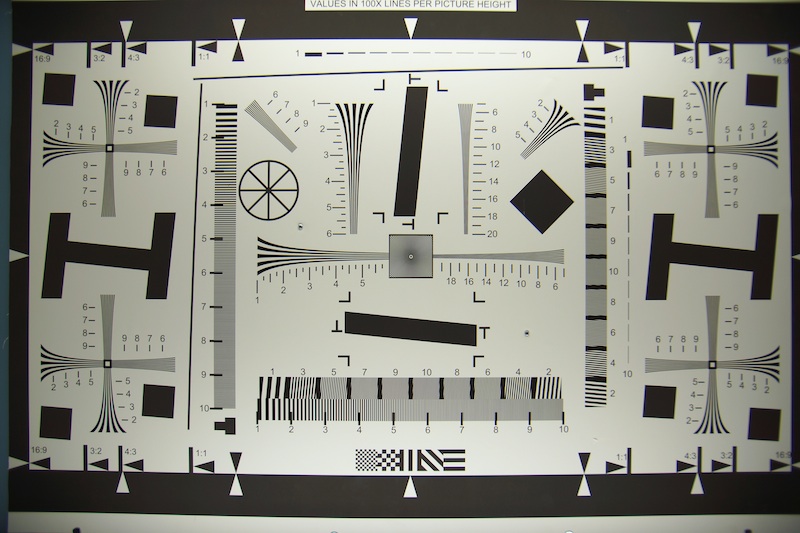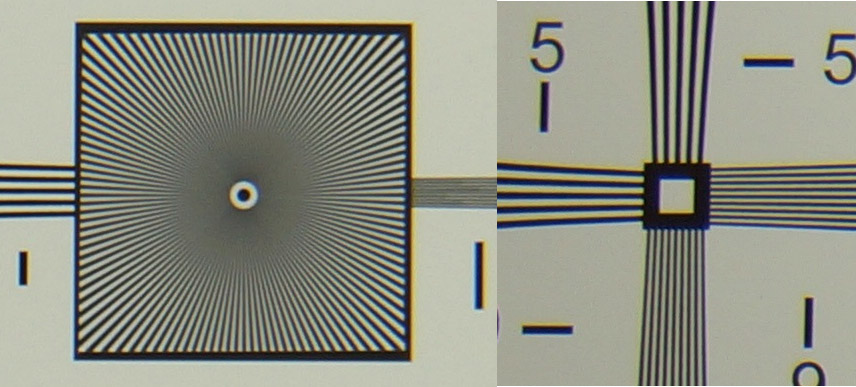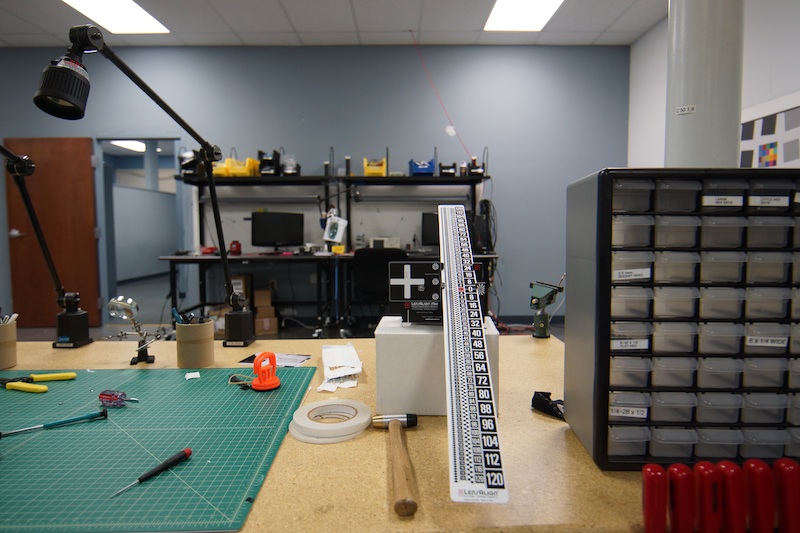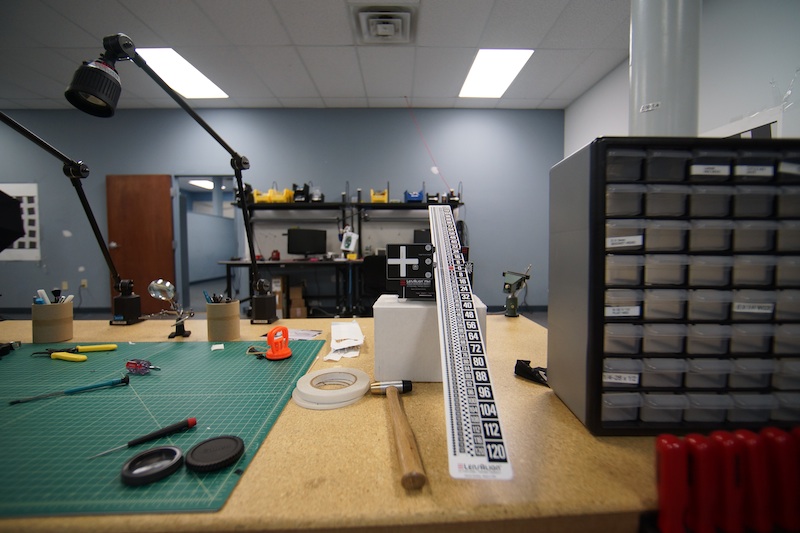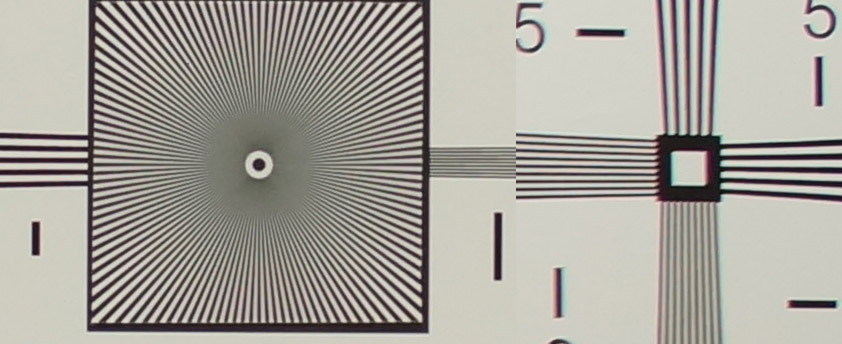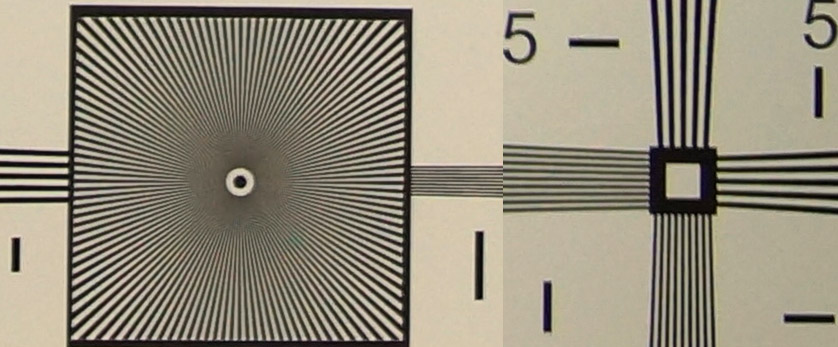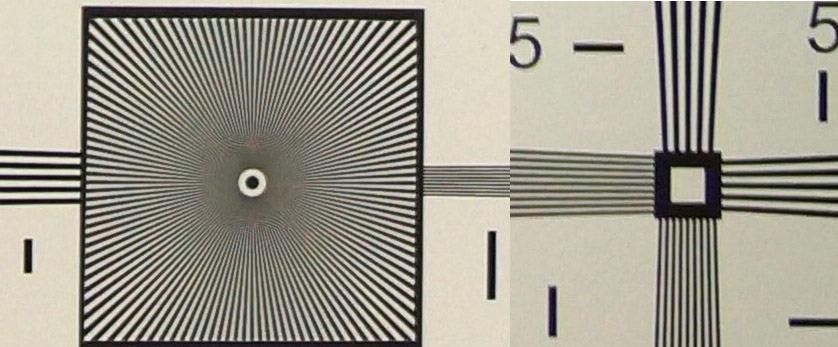Lenses and Optics
Metabones Magic?
A few days ago I learned about the Metabones Speed Booster. For both of you who haven’t heard yet, this is an adapter containing optical elements and electronic controls that allows you to mount Canon EF lenses to Sony NEX cameras (other versions are planned for other lenses and cameras). The quick summary is the adapter is the opposite of a teleconverter.
A teleconverter spreads out the light leaving the lens so that only the center portion reaches the sensor. The result is the focal length of the lens seems longer (the image is magnified), but at the cost of reducing the amount of light (effective aperture) of the lens. The Speed Booster compresses the light leaving the lens onto a smaller image circle. This makes the focal length seem shorter and actually increases the amount of light reaching the sensor.
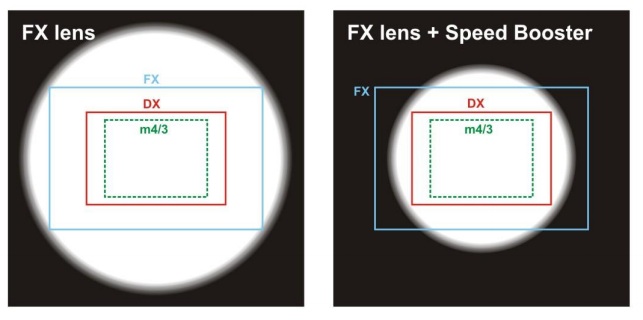
- The Metabones’ Speed Booster compresses the light leaving the lens into a smaller image circle. Image credit Metabones http://www.metabones.com/images/metabones/Speed%20Booster%20White%20Paper.pdf
The EF to NEX Speed Booster, for example, changes the effective focal length x 0.71, and increases the maximum aperture by 1 stop. A Canon 50mm f/1.2 lens effectively becomes a 35.5mm f/0.9 NEX lens, for example. Videographers all over the internet were singing Hosannah and laying palm leaves along the path of it’s introduction.
I went into my office, shut the door, and sobbed quietly for a while. Why, you ask? I’ll tell you why. About once a day, we get an email saying somthing like, “I just rented a Canon 5D Mk III and shot video of my daughter’s high-school graduation. My footage doesn’t look anything like Vincent LaForet’s. Obviously the camera was defective and I want my money back.”
This adapter was, I thought, going to result in another 50 emails saying, “I just shot video using a generic 50mm f/2.0 lens I bought on eBay with the Speed Booster adapter and Sony NEX VG20 I rented from you. The footage doesn’t look anything like the footage shot with a Zeiss 35mm T1.5 Super Speed shot on a RED Epic. Obviously the equipment is defective and I want my money back.” I know, like I know the sun is going to rise in the east tomorrow, that you don’t put some more glass between a camera and a lens and get a better image.
But marketing hype will be marketing hype and people who want to believe in magic will believe it – and be disappointed when the magic doesn’t happen.
But Then, There Came a Ray of Hope
Then I flipped over to Metabones’ white paper on the Speed Booster and spit coffee. The primary designer of the adapter is Brian Caldwell. If anyone could make optics do magic, he could. He designed, for example, the Coastal Optics UV-VIS-IR Macro lens, an amazing thing that is the gold standard for forensic macro photography. So I read the white paper carefully and it made perfect sense. The White Paper explained how:
- The Speed Booster introduces zero (none, nada) spherical aberration, even with an f/0.9 output. That’s amazing. The very complete graphics in the White Paper do show it adds a bit of astigmatism and distortion, though.
- Where teleconverters magnify lens aberration, a focal reducer would reduce aberations basically because it would shrink them.
- The adapter is physically smaller than a standard, non-optical EF to NEX adapter.
- Corner illumination is improved.
After reading the white paper, I became convinced that these things were true. And these are all good things.
There was an additional claim made in the white paper, that MTF (modulation transfer function – acutance and resolution) was also improved. This one I struggled with. To be blunt, I found this section to be, shall we say, selective, in the comparisons made. I was left with the feeling that it might be using some very specific examples to suggest a general conclusion. The section was a bit more carefully worded than other parts of the white paper, and some information in the graphs, that didn’t quite agree with the claim, was downplayed in the text of the section.
I was willing, however, to be convinced that an FX lens mounted to the Speed Booster would have better corner resolution mounted to a Micro 4/3 than the same lens mounted to a full-frame camera – after all, those Micro 4/3 corners are a lot closer to the center of the image. And that it may, or may not, have better corner resolution mounted to an NEX camera compared to a full-frame camera.
So after my research, my impression was this will be, at least a very useful tool. It may be nearly as good as people hope it will be. In other words, it will, like all other imaging gear ever made, follow Roger’s Law of New Product Introduction (pathway A).
Let’s Do Some Testing Boys and Girls!
OK, first and foremost, this is not going to be a bunch of video samples. That’s not what I do. I’m a testing geek that writes words and makes graphs. But for those who have bravely come this far without a picture to ease the heavy burden of reading, let’s have a look at the Metabones Speed Booster.
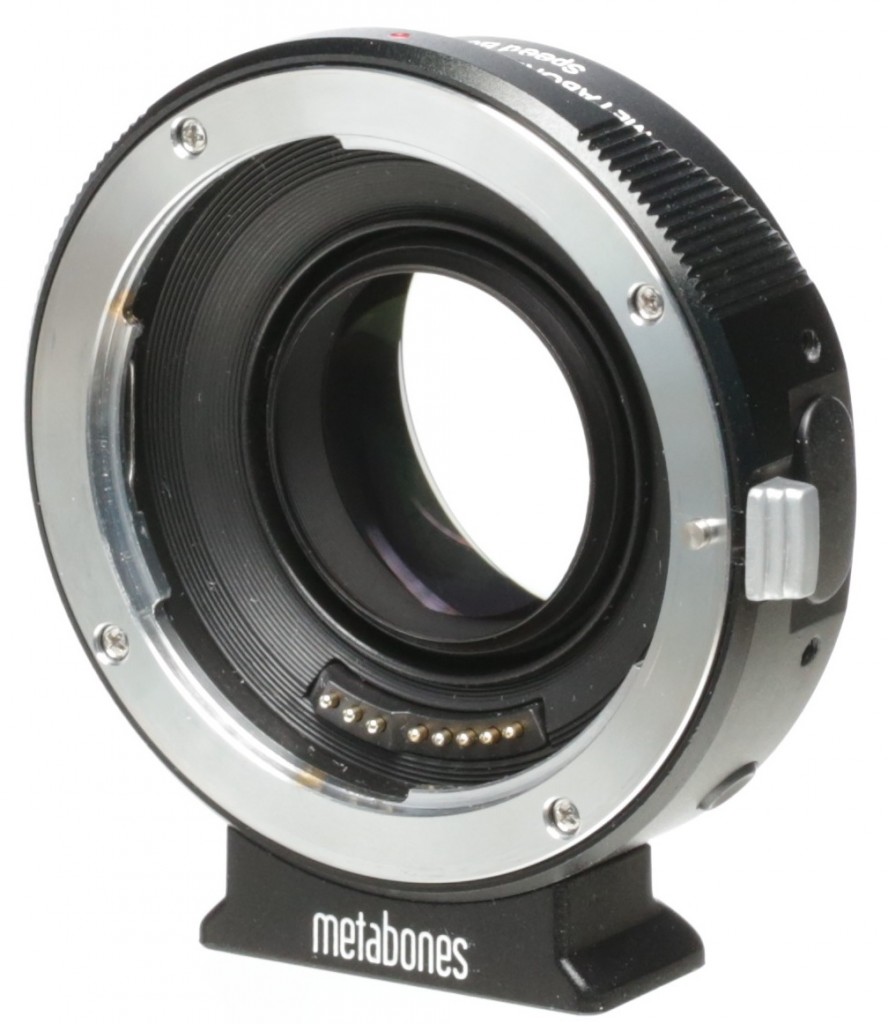
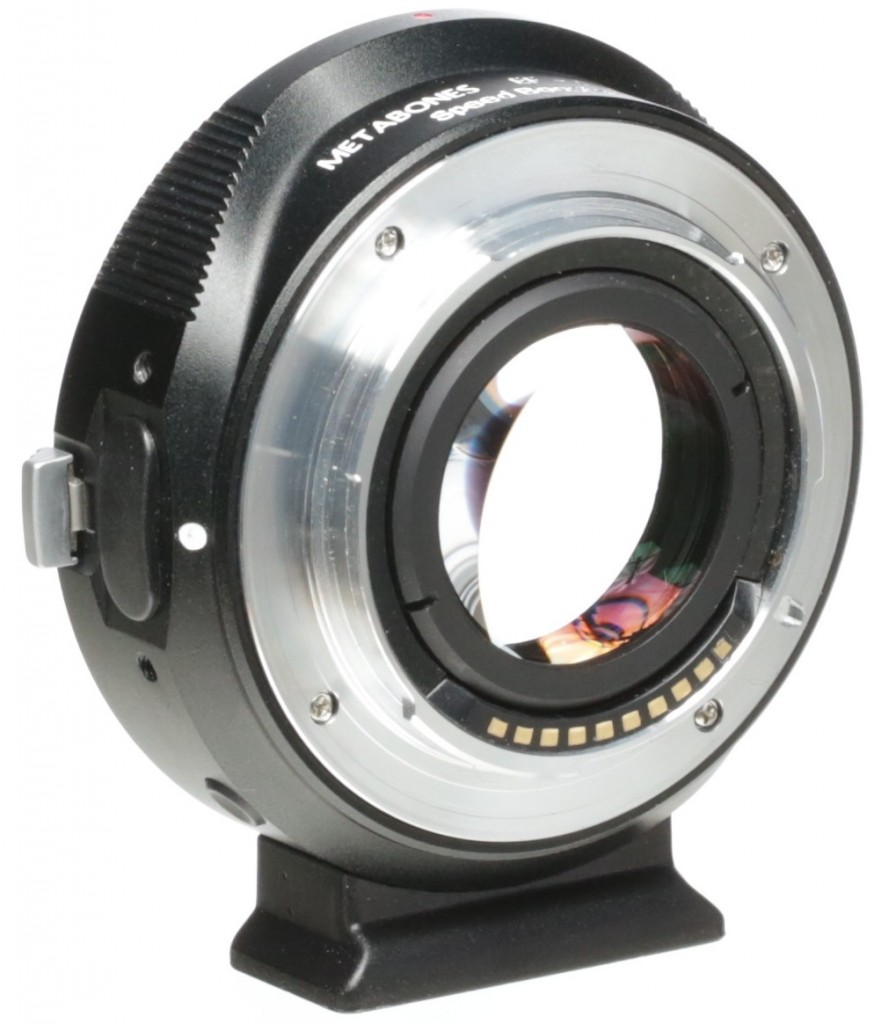
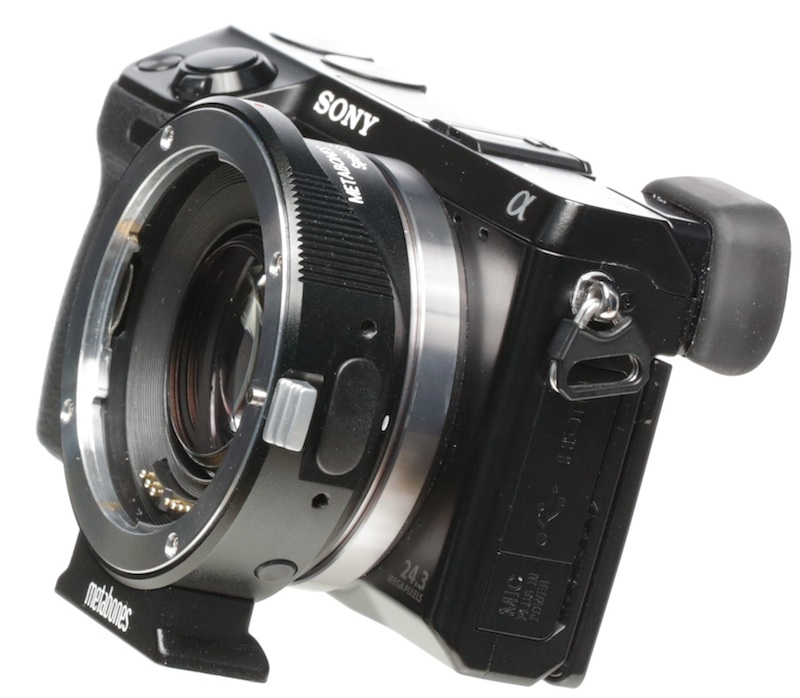
- Mounted to an NEX-7 (don’t mind the dust, it’s a testing camera)
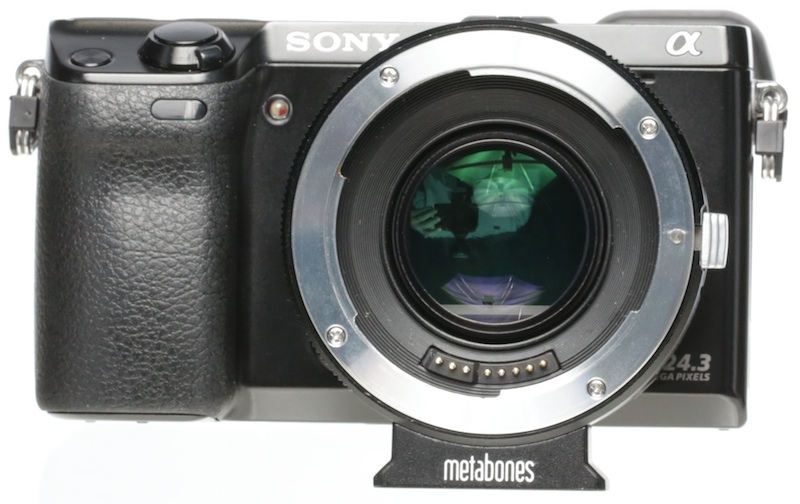
- Note the front glass nicely reflecting the right hand of your humble author.
It’s a nice looking bit of kit – solidly made and well put together. There’s a solid mount for tripods or shoulder mounts underneath. It mounts with a most satisfying thunk and clamps tightly to camera and lens. The optics are close to the surface, though, and some care in handling will be necessary to make sure they don’t scratch.
Let’s Shoot a Few Test Charts
There are a lot of ways to compare lenses with the Speed Booster and not a lot of time, so I tried to choose things that seemed practical. Or cool. Or both.
Starting with cool, I mounted a Canon 14mm f/2.8 II lens, which with the adapter should give us the equivalent of a 10mm f/2.0 NEX lens. That sounds cool to me. Plus I thought we should look at things as extreme as people are likely to get.
We’ll start by comparing simple shots of an ISO1223 chart shot with the lens on a plain adapter and on the Speed Booster. To even things up I moved my position so that the chart filled the image each time, so that we could compare resolution directly. First an overall picture of the chart, followed by center and near corner crops with each adapter.
Canon 14mm f/2.8
Again, the images were from different distances so that the chart filled the image with both shots. It’s not an optically critical test, but I’d call it a complete success for the Speed Booster. Even spotting the original image 1 stop of light, there’s no significant difference in resolution to my eye.
The change in perspective is impressive. These are shot from the same location with the Canon 14mm f/2.8 mounted to a straightforward adapter first and the Speed Booster second.
Canon 50mm f/1.2
That was pretty impressive, now lets stress things a little bit more. The Canon 50mm f/1.2 lens brings a few aberrations to the table and with the adapter will be an f/0.9 equivalent. I can’t think of anything that would stress an adapter more than f/0.9. Again, I’ll reposition myself so both shots fill the frame with the chart. We’ll compare the 50mm f/1.2 on top to the Speedboosted 35.5mm f/0.9 below.
Again, these are not critical tests, but are carefully lined up, best focus of several shots. And again, the Speed Booster comes out very well. It may be the illumination boost but the acutance in the center, at least seems a little better with the Speed Booster. I would draw your attention, though, to the difference between vertical and horizontal lines in the corner crop of the Speed Booster image. That’s not an artifact of the shot or alignment. With this lens and camera, at least, the astigmatism seems to be showing up a bit. I also note that the image looks oversharpened, but it’s an unsharpened JPEG and this appearance was consistent on multiple shots.
Canon 135 f/2.0
I wanted to try the other extreme, and made the assumption that this would be about the longest focal length people would want to use the Speed Booster with. I may be wrong about that, but was running out of time today.
Again, if there’s any deterioration in image quality with the Speed Booster, even though it’s a stop of aperture wider, I’m having difficulty seeing it. I also don’t notice the astigmatism with this combination.
But let’s test the resolution a bit more critically.
Imatest results
We don’t have multiple copies of the Speed Booster yet, so this is what we did. We took a Canon 50mm f/1.2 lens and tested it on a Canon 5D Mk II camera. Then we tested that same copy on an NEX-7 using a standard adapter. Finally, we tested those same copies (camera and lens) with our Speed Booster.
Usually when talking about Imatest results I’m sampling dozens of copies and give you the average (mean) resolution in the center and a weighted average of all the test points on the lens. But usually we NEVER test lenses on adapters if we can avoid it. Why? Because even the very best adapter still introduces and extra variation in tilt and centering between the lens and the camera.
Let me word this more carefully because it’s important. When the imaging sensor is placed in the camera, it is carefully lined up to be completely parallel to, and centered with, the lens mount of the front of the camera. A tilt of 20 microns may be visible on a very wide angle lens. A tilt of 40 microns almost certainly will be visible. From repair manuals we know that the sensor can be made parallel to the lens mount within a few microns so that’s taken care of.
But when the big, heavy lens mount rotates into the big, heavy camera mount, chances are it’s not accurate within a few microns. Let’s assume it’s getting close to the 20 micron limit, because we know with high-quality, wide angle lenses we can often see some side-to-side variation. Sometimes obvious with some pixel peeping, sometimes not at all, but frequently enough that I’ve assumed we’re getting close to tolerance.
This is one of those sources of lens-camera variation I talk about so often. Lens 12345 looks great on camera 54321 but not so great on camera 112233. It may tilt a bit more on that second camera mount.
When we add an adapter we’re adding another heavy duty mount and making it more likely there’s a bit of tilt. It’s rarely apparent (with a high quality adapter) at standard or telephoto ranges, but often can be detected with high resolution wide-angle lenses. It may cause no harm at all. It may create too much tilt. I mention all of this because it’s going to explain some of our test results.
Canon 50mm f/1.2 on a Canon 5D Mk II
On a Canon 5D Mk II and our lens shot at f/1.4, the MTF50 was 590 line pairs / image height in the center; 460 lp / ih averaged over the entire lens, and 265 lp / ih in its worst corner with a barrel distortion of 1.2%.
Canon 50mm f/1.2 on a Sony NEX-7
On the NEX-7 with a standard adapter shot at f/1.4, it resolved 625 lp / ih in the center, 485 averaged over the entire lens, and 210 in its worst corner with a barrel distortion of 0.825% (smaller sensor). The difference in the center and overall isn’t surprising – the NEX has a higher pixel density and is using the ‘sweet spot’ from the center of the lens. The fact that the lowest corner is worse is a bit surprising until you see the overall graph of results:
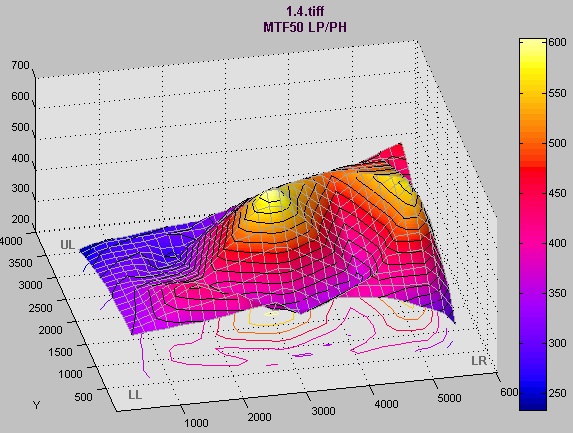
- Graph of MTF50 results on NEX camera with standard adapter
Notice the upper left corner is worse and the upper right better, and that the right side of the image resolves better than the left. The lens, which behaved very nicely on a Canon camera, is tilted when shot on this particular NEX-7 with this particular adapter. So, of course, we went and got another adapter. It tilted the other way. And we were out of time. From experience I can say the center resolution number is going to be accurate, the actual weighted average should be a few points higher and the worst corner about 275 or so rather than 210 (275 is the resolution on the less affected corner).
So it is with adapters. And before you scream that the adapter was bad, it wasn’t. The guys put those adapters on other cameras and lenses later and they were either dead even or tilted another way. It is what it is. Also remember we’re churning MTF 50 numbers. You need a big difference to be able to actually see the difference in a photograph, and an even bigger difference for it to affect video.
Canon 50mm f/1.2 on NEX-7 with Speed Booster
On the NEX-7 with Speed Booster adapter and shot at f/0.9, it resolved 720 lp / ih in the center, 410 averaged over the entire lens and 230 in the worst corner. Stopped down to f/1.3 the MTF 50 increased to 800 center, 510 weighted average, and 300 for the worst corner. As advertised, the MTF 50 increased compared to the same lens on no adapter.
However, barrel distortion increased to 1.9%. Remember, however, this is in effect now a 35mm lens, so that number isn’t as big a jump as you would think at first glance. Just to note, there was no sign of tilt with this adapter on this camera.
One thing to note – there was definitely a bit of astigmatism, with horizontal and vertical resolution quite different along the edges of the lens. One other interesting note – we measured primarily MTF 50 as this is the number we work with most frequently. We also checked the MTF 20 numbers and for these combinations the Speed Booster had a similar effect: slightly improved but with greater astigmatism.
A reminder for everyone again – we had one copy of the adapter to play with and limited time. But I’ll have to admit that it seems the folks at Metabones pulled off what they claimed: with the adapter a lens is wider, faster, and even a bit sharper.
A Few Images
There’s not a lot of photogenic material around the Lensrentals Lab, but how often do I get to shoot with a 35mm f/0.9 lens? I’ve included some 100% crop areas in the corners of the scaled down shots.
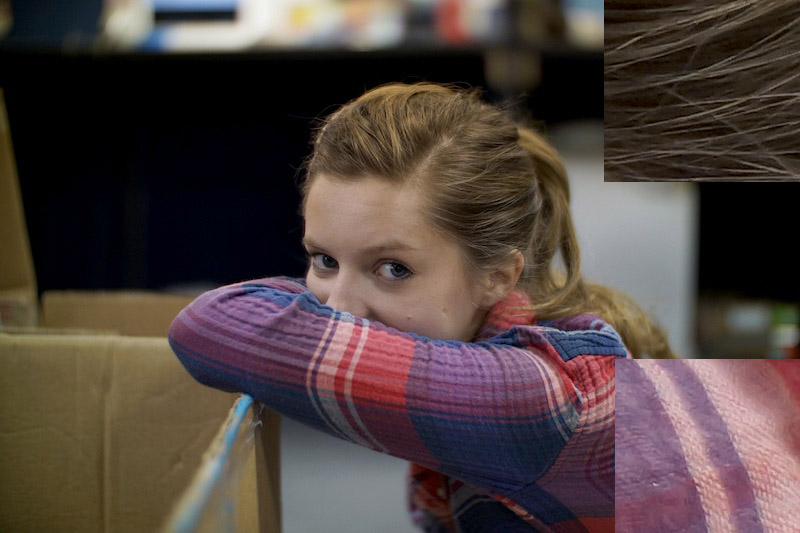
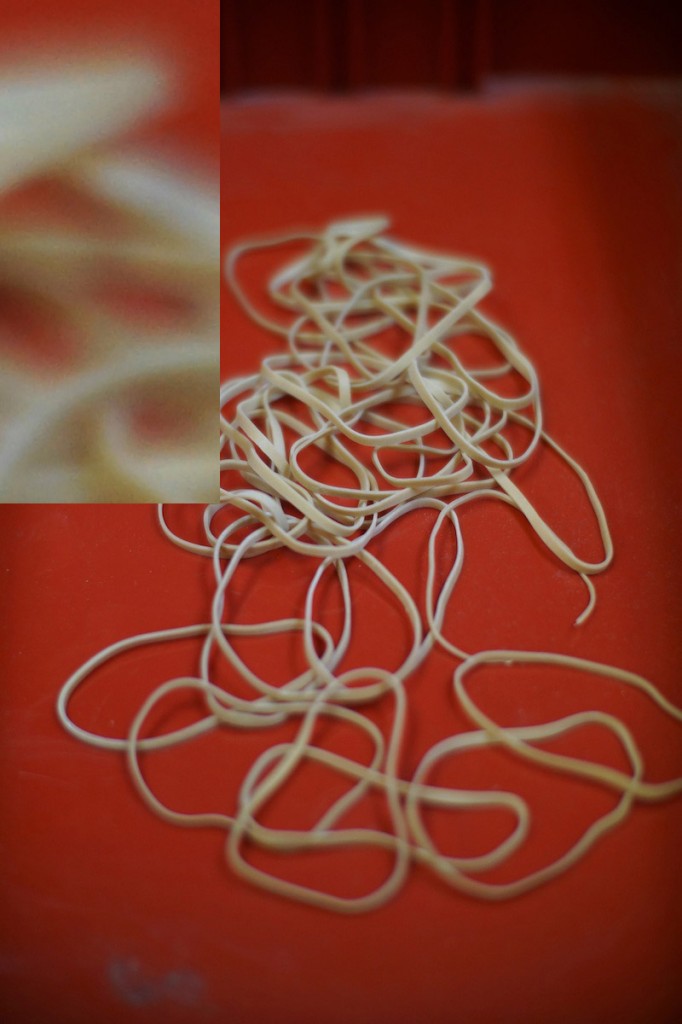
Now, to get completely subjective, there’s something about the images as far as photography that I don’t like, but it’s hard for me to put a finger on it. But if you look at the crops there’s a bit of a glow around highlight areas, both in-focus (in Sarah’s shirt) and out of focus (the rubber bands).
My first thought was perhaps shooting on an NEX -7 could be the issue, since we know that camera has had some problems with adapted retrofocus lenses. Shooting with a Canon 50mm f/1.2 may also be the culprit – that lens is, well, different. But we repeated the rubber band shot with an NEX-6 and then with both cameras and a Canon 85 f/1.2 and the Speed Booster. To my eye (and remember I’m a techie, so I don’t do subjective all that well), there’s a real tendency for highlights, in and out of focus, to bloom a bit at the widest apertures. It seems to go away by f/2.0 affective aperture.

I’d also add, for those who plan on using it, that the autofocus worked well as far as accuracy. Eventually. You won’t be catching any moving targets unless they are turtles, though. I doubt this is of great import to many people, though.
Conclusions
I think it was pretty obvious that I came armed for battle, ready to slam this product as some marketing overhype. I was wrong less correct than I might have been. The Speed Booster does what they claimed it would do, much to my shock and surprise. It creates a wider-angle, greater aperture lens while retaining resolution and acutance.
It does increase astigmatism a bit, although I doubt this will cause anyone problems unless someone is trying to shoot landscape photography with it. It also seems to create some highlight blooming at very wide apertures. Again, nothing that can’t be worked around and probably not something that will be noticeable with anything but the widest aperture lenses.
It is going to take a while and a lot of people experimenting before we find out what combinations of lenses and cameras are awesome with it, which are fairly good, and which fairly bad. They won’t all be the same. But I suspect most of them are going to be pretty good. And this is going to be a very useful tool.
Most of the little foibles I’ve seen (including the part about adapter tilt) really only apply to photographers trying to tweek every drop of resolution out of their high-resolution sensor. Video, even 5k video, is more forgiving of a slightly weak corner or a bit of astigmatism.
Roger Cicala
Lensrentals.com
January, 2013
Author: Roger Cicala
I’m Roger and I am the founder of Lensrentals.com. Hailed as one of the optic nerds here, I enjoy shooting collimated light through 30X microscope objectives in my spare time. When I do take real pictures I like using something different: a Medium format, or Pentax K1, or a Sony RX1R.
-
Ney Frota
-
ney frota
-
Jan Steinman
-
John Gaylord
-
Nick Seth-Smith
-
Fabiano Silva
-
Flavio Egoavil
-
Samuel H
-
Timmi
-
Timmi
-
Voodoo Fox
-
Aaron
-
Samuel H
-
Lisandra
-
Lisandra
-
Samuel H
-
Sggs
-
Robert Spanjaard
-
Samuel H
-
Robert Spanjaard
